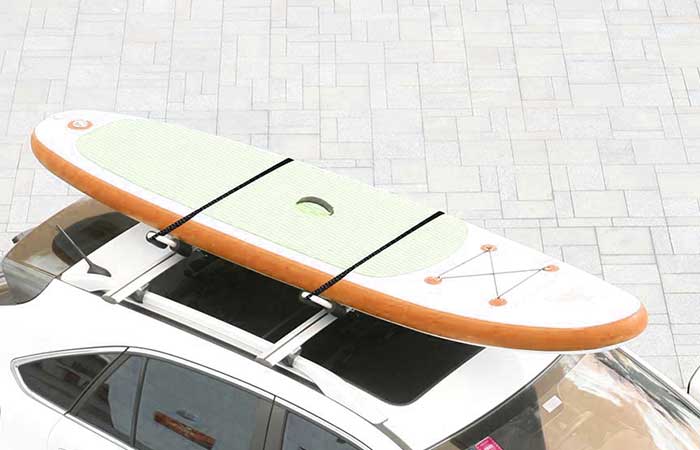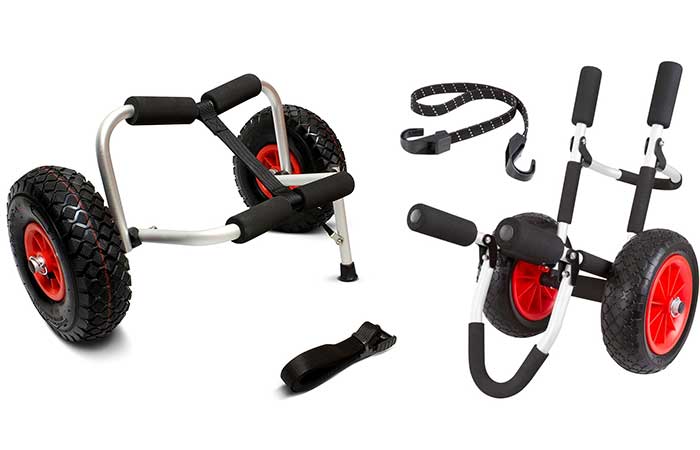How to Store Stand Up Paddleboards
Proper SUP board storage is crucial to the longevity of the paddleboard since many factors could affect its lifespan, including abrasive elements like grime and salts, extended sun exposure, and moisture.
You can store your paddleboard either indoors or outdoor by simply leaning it against a vertical surface, using freestanding, wall-mounted or ceiling racks, or by hanging it using hoists and strap systems. The ideal storage location and method will depend on many factors.
The following is a detailed discussion on how to prepare the SUPs for both short and long-term storage, different indoor and outdoor storage methods and tools, factors to consider and tips to keep your boards from damage
Why Store SUP Boards Properly?
SUP boards are an investment; therefore, you must care for them and keep them serving you for longer. Here are the common reasons you should properly store your board:
- Theft protection – paddle boards cost a lot of money, especially the solid, epoxy kind made with bamboo, which can be costly. Therefore proper storage ensures you keep your board away from prying eyes.
- Heat exposure – keeping your board under the sun or close to hot environments like a water heater or boiler can cause deterioration to the material, delaminated rigidity of the board, or a busted seam if it’s inflatable.
- Sun exposure – leaving your paddleboard under the sun for too long can also delaminate the shell of the board’s material, especially if it’s made from fiberglass or epoxy. The sun can also bust seams on your inflatable SUP. Additionally, the sun’s harmful UV rays can discolor, crack, or warp your board’s shell.
- Moisture exposure – leaving your board with water creates a conducive environment for mold, mildew, and bacteria to grow. As the mildew infestation grows, it can severely damage the outermost layer/shell of the SUP board.
- Damage from animals/insects – mites and other insects can feed off your paddleboards, especially those made out of pure bamboo.
- Improper handling – if you leave your sup board lying just about anywhere, it could easily get damaged from constant scrubbing, falling, or scratching against surfaces which causes the board to get teats, cuts, and scrapes.
Now that you know why it is vital to store your paddle boards, let’s jump into preparing your SUP board for storage.
Preparing Your SUP for Storage
The idea is to clean, dry, and deflate before storage, but you may need to do more for long-term storage.
Short Term/Overnight
Follow these steps below to prepare your board for short-term storage.
- Spray your board with clean water to get rid of grime, salts, dirt, and debris.
- Dry it using an absorbent towel.
- Store it either horizontally or vertically. Either way, keep it away from the ground since it may be cold and could absorb the water that you might have missed from the SUP board.
Long-term
During the winter season and part of autumn, you could use these methods to store away your paddleboard until the next sunny season.
- Wash your board thoroughly using a hose with clean water, a sponge, and a mild cleaning solution or dish soap. The soap will remove all residual and stubborn stains, dirt, grime, and microbes from the saltwater.
- Dry the paddleboard using a cloth or let it air dry, so it drips water completely.
- Wax/polish your board’s shell to keep it shiny and clean. Fiberglass SUP boards can easily be waxed but be sure to look through your manufacturer’s recommendations.
- Disable your solid paddleboard -detach the fins and the leash.
- If the board is inflatable, you can deflate the board.
- Store it in a bag or cover it for that last finish. The bag, which should be waterproof like a tarp, will prevent exposure to moisture, the sun, or pests for as long as it’s covered. Ensure you strike a balance between aeration and protection to avoid the accumulation of moisture.
If you’re storing the board indoors, you won’t have to store it inside a bag/cover.
Outdoor Paddle Board Storage Ideas
Outdoor storage is ideal because of extra space, so outdoors would be a great choice if you have more than one paddleboard. Nonetheless, there are a few factors to consider.
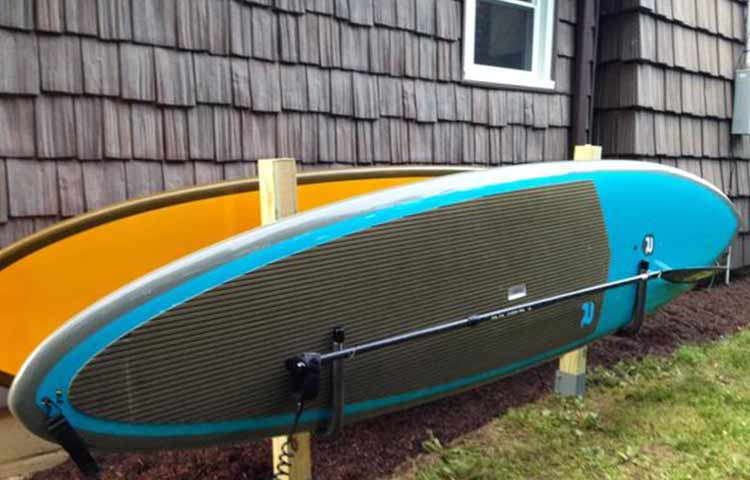
What to Consider When Storing Outside
Being in the open creates a leeway for many contaminants to get into contact with your board, including UV rays, heat, and moisture. If you plan to store your SUP board outdoors, here are a few factors to consider.
- Moisture and heat protection – to store your board safely away from these elements, choose an outdoor space that may protect the board from heat and water damage. For example, you can store it in a shed, shade, or over your car with a cover over it.
- Theft protection – you have limited options as to where to keep your paddle board safely. You can choose to place it beneath a deck, below the roof’s eaves, or under a tarp as those are the safest places.
- Seasons – you should never consider storing your board outside during the winter. The climate is too cold and will affect the rigidity of your board, plus snow can impair the board altogether.
Storing outdoors presents many risks ranging from theft, damage from rain or snow, and exposure to the sun’s UV rays. If you must store your board outdoors, make sure you address all these issues.
Methods of Storage
There are five ways you can store your paddle board. They include:
- Racks
- Hanging/suspending
- Leaning
- Freestanding Holders under a shade
Outdoor Racks
There are outdoor racks you can use to store your paddle board. Outdoor racks are made especially for the outside because most will have a rust-resistant coating to help protect them from corrosion caused by extended exposure to moisture. The rust-resistant coating can be made from epoxy or powder coating that offers a barrier from humidity.
With the racking system, you can get a single rack or multiple, where you stack them together and place them away from harmful elements. The racking system is prevalent amongst borders because it’s cost-effective and customizable.
One of the top outdoor SUP storage racks is the Rad Sportz Paddleboard & Kayak Rack Double Stand. It is all metal, can store up to two boards at the same time. You can place it anywhere, indoor or outdoor.
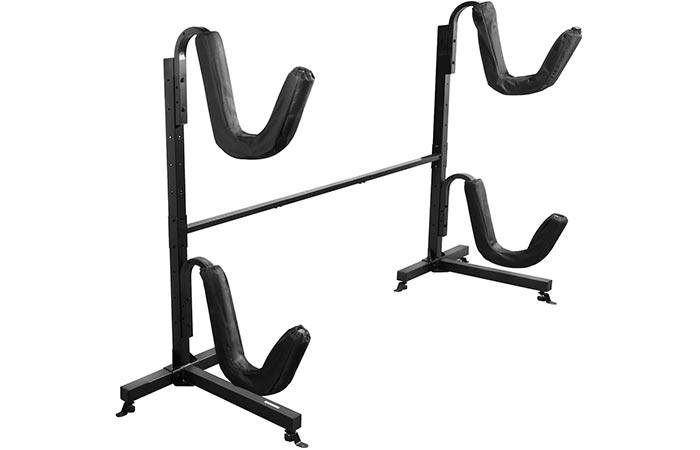
Another both outdoor and indoor storage option is the Sparehand Dual Storage Rack. It is a heavy-duty freestanding and an easy-to-install rack made of tubular steel for 2 kayaks or SUPs
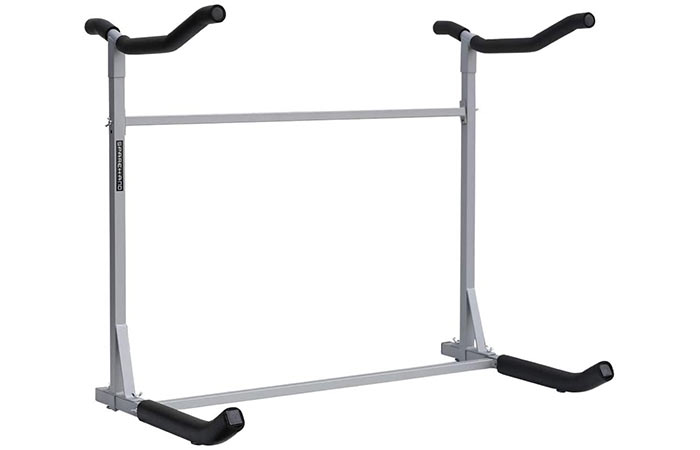
Onefeng Sports Stand Storage Rack is yet another outdoor alternative that comes in a unique design. It is a 29’’ tall foldable (very portable) made of aluminum frames with soft-touch saddle and pads. It is ideal especially if you have large paddleboards

Suspended/Hanging
If you plan to suspend your rack, you can use straps to hold down your paddleboards from either side of your deck or other outdoor areas you plan to store the board.
The biggest concern is pressure from the straps; if you strap on too strong, it could damage the outermost coating of the board, so be gentle with it. Alternatively, you can get padded straps/ DIY webbing straps. Some of our best picks include;
Pelican Double SUP/Kayak Storage Strap System

It comes with 2 fully adjustable straps for hanging SUPs and Kayaks and 2 loops for holding paddles or oars.
Heavy duty extra wide 1. 5″ webbing well designed, strong, easy to install and most importantly they don’t damage the kayaks or boards.
Easy to use Stainless steel heavy-duty carabiners and D-ring closure system
Another good hanging storage option is the COR Surf Heavy-Duty Padded Wall Storage Sling/Straps for Kayaks or Paddleboards
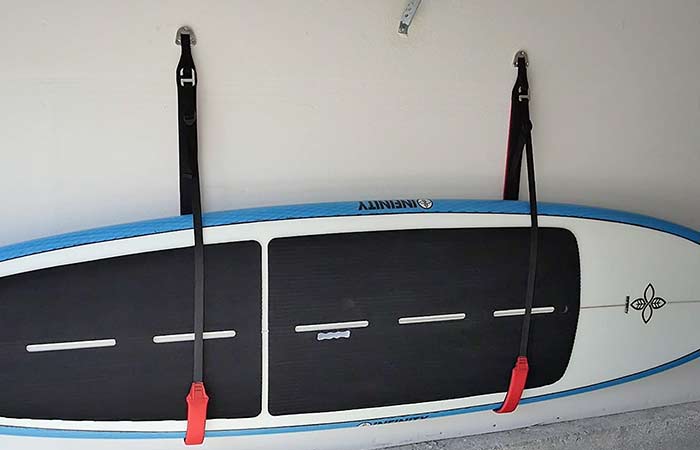
Leaning
Leaning is the easiest storage method since all need is to you lean the board against a wall or any vertical surface. However, be careful of how and where you lean the board.
You want to make sure you raise the board a little higher off the ground so the board isn’t constantly scratching and grinding off the ground as this will cause it to damage.
Ensure that the board is on its tail or side and never the nose. The board should be kept at a good angle not to damage the ceiling or get in the way or people moving around.
You can also secure the board as its slippery surface can easily lead to it getting damaged when it slips and hits the ground.
Unfortunately, leaning won’t apply to all your boards because some boards are as long as 11 feet, so watch out for that.
Freestanding SUP Holders
Freestanding is very similar to leaning, but you would use a freestanding rack to keep the board off the ground and keep the board securely in place without falling over or grazing on the floor surface.
Again, with most of the other storage methods, these ideally are workable in shades or decks where the board remains safe from damage.
A good product for this storage method is Suspenz Double-Up SUP Stand/holder.

it is a lightweight outdoor/indoor storage for up to two boards. It is made up of epoxy powder-coated aluminum frame and comes with neoprene foam pads to protect the boards from damage
Pros and Cons of Outside Storage
Outside storage is ideal for storage and probably fast access to your paddleboard. Ideally, it can also look appealing but placing it as a decor would damage the board because of exposure to rain, heat, and UV rays from the sun.
That’s where the cons come in; outdoor storage presents many risks and so many ways your paddleboard could get damaged, not to mention stolen. Outdoor storage offers a vast space for storage but limited areas for storage, in that you can only store it in shades or hidden spots where you’re assured they won’t get direct exposure to damaging elements.
That’s said, outdoor storage is okay, and as long as you can find ways to keep your paddleboard safe, then it’s an ideal storage choice.
Indoor Storage
Indoor storage presents multiple choices from the basement, garage, extra rooms in the house, or the living room, which is why it’s the best type of storage because it offers the most protection from harmful elements like moisture, heat, and the sun’s UV rays. Nonetheless, there are a few factors to consider.
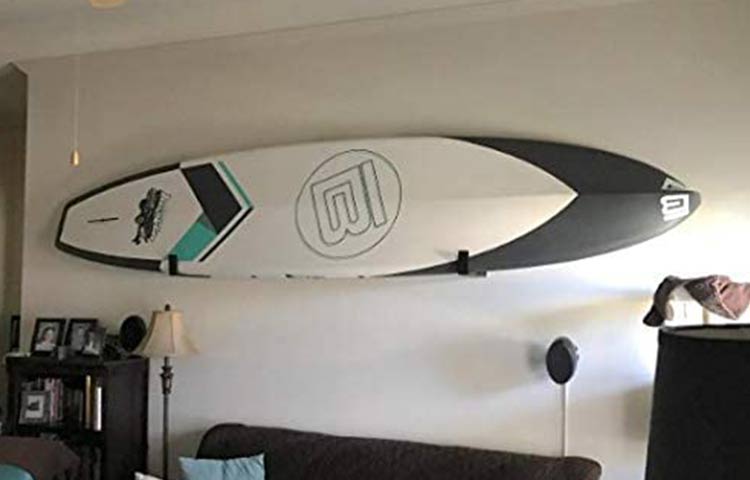
What to Consider When Storing Inside
Before fixing a rack in the house to store your board, consider:
- Space – your indoor space may be very limited, especially if you stay in apartments or small homes.
- Humidity – while the interior protects the board from obvious elements like rain and the sun, the accumulated moisture from inside could also damage the rack.
- The number of boards – one SUP board used fine, but an entire collection would be hard to store inside unless you have secluded storage space inside the home.
Ways to Store Them Indoors
There are several ways to store your paddle board inside the house.
- On a ceiling rack
- On a wall rack
- On a vertical rack
- On a hoist/rafters
Ceiling Rack
Ceiling racks are overhead racks mounted on the ceiling for additional storage. There are many options for ceiling racks like steel frames, straps, single or multiple racks, and assisted ceiling racks with push or pull mechanisms. These racks are secured on the house’s ceiling, to safely hold your boards high above the ground.
A good example StoreYourBoard’s Double SUP & Surf Ceiling Storage Rack

It is a space-efficient two-sided overhead rack that can holds 2 paddleboards at home, garage, or paddle shop.
The center column can adjust from 10″ to 18″ tall to provide you the storage thickness that fits your space and storage needs; remove the arms with the push of a button.
Wall Rack
Wall-mounted racks can be placed anywhere, from the basement, bedroom, and living room, as additional decor. These wall racks are anchored securely on the wall using studs or bolts to keep it sturdy and stable. You can configure these storage racks whichever way you like, including using a wall cradle for one board or multiple boards.
Wall-mounted racks are great where you have enough wall space because the boards can lie horizontally comfortably hence no likelihood of damage.
Recommended products
SPAREHAND Wall Mount Rack with Angled Padded Arms for Surfboard or SUP Paddle Board double storage
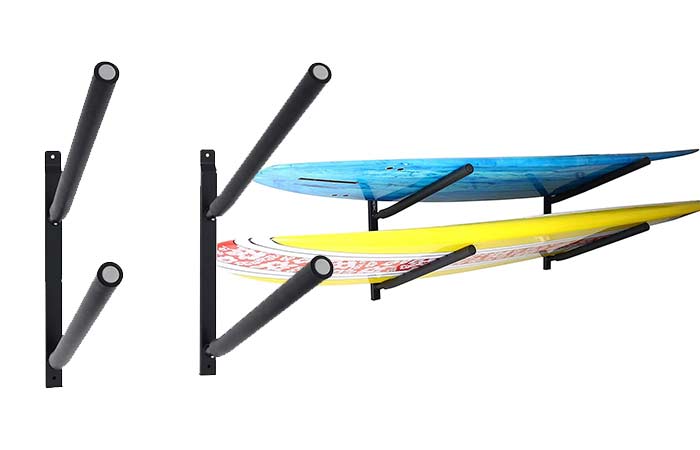
Best Marine Kayak Storage Racks. Premium Wall Mount Accessories for Kayaks and SUP Paddle Boards. Two Indoor/Outdoor Kayak Hangers

Rad Sports Kayak/Paddleboard Storage Hooks
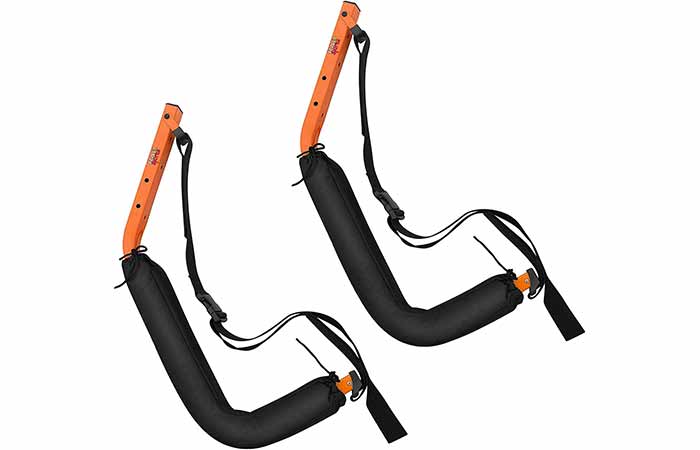
The Rad Sportz hooks are constructed from sturdy powder-coated steel and equipped with nylon holding straps and clips. The foam-padded hooks can be mounted right into your wall studs to safely boards up to 125-pounds
Freestanding Indoor Racks
These are same as the outdoor racks. The difference is that they can only be used indoors.
Steve’s Rack Shack is one of the best freestanding indoor storage options. It is 3-level, 31″ tall, and made of premium wood.
It comes with protective foam on the arms to promote safe and simple storage as well as a place to repair dings and work on boards.
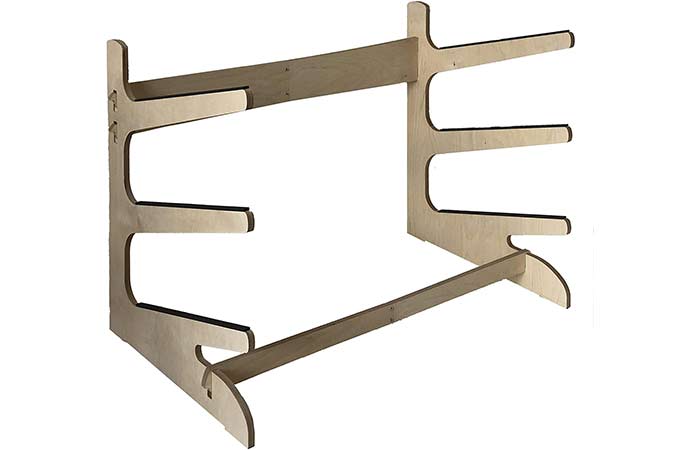
Vertical Rack
A vertical rack uses vertical space in your home to store your boards. The storage is freestanding but raised from the ground to prevent damage. These vertical racks are space-saving very versatile, and you can use them for display.
They can accommodate up to six boards. SPAREHAND Glacik Vertical Storage Rack is one of our top picks.
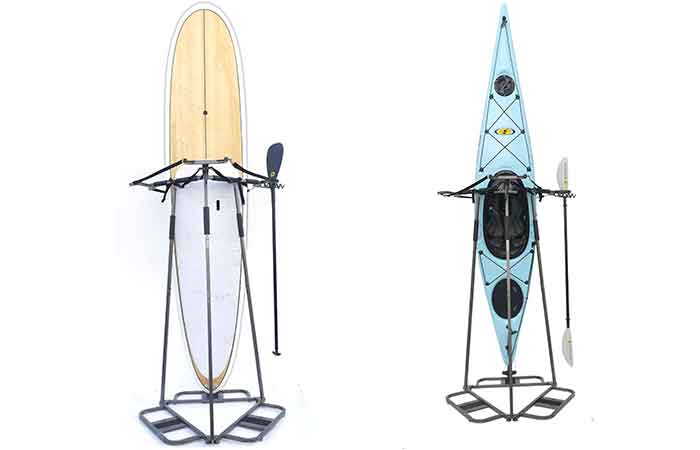
Sparehands’s Glacik rack is convenient and versatile storage for up to 3 kayaks or 6 SUP boards. Ideal for use both indoors and outdoors. Includes holders for better paddle storage.
Rafters
Lastly, there are rafters or holders or hoists which are a specialized kind of storage systems which use a pulley to raise the boards off the ground.
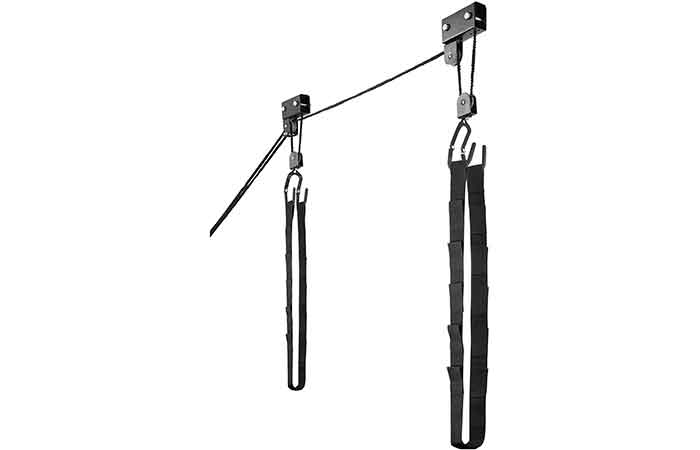
They can lift the board to the ceiling without you having to lift it yourself. They’re very similar to veiling racks, but these rafters are freer, and they tend to distribute weight evenly compared to wall-mounted or ceiling-mounted racks.
Because they hang free from the ceiling, it’s best to remove the fins because they can offset weight balancing and get damaged as people move around and about the home.
StoreYourBoard SUP and Surfboard Ceiling Storage Hoist is one best product we would recommend for this method of storage
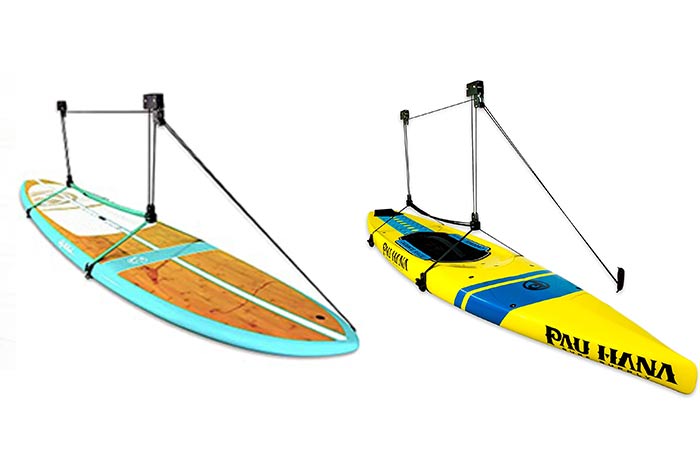
These are high-strength adjustable straps and storage hooks to securely store your paddleboards from your ceiling. They come with a locking mechanism that lifts easily, is safe and simple.
Pros and Cons of Indoor Storage
Indoor storage offers a variety of locations to store your paddle board. Additionally, indoor storage provides the most protection from the damaging elements of water/moisture, heat, and UV rays. Because the board remains in your vicinity, you can be assured of safety from theft as well.
Indoor storage also adds a certain appeal to the home, especially if you choose to showcase your boards rather than storing them away.
On the downside, indoors can accumulate moisture, so if you’re covering your paddleboards, you have to check on them to ensure they remain dry throughout regularly.
The inside of the home can also get hot so aerate the boards as often as you can, especially the inflatable kinds, because hot air in the board will expand and damage the board if left completely inflated.
How can I Store my Paddle Board in the Garage?
Garage storage is a no-brainer, especially for long-term storage; they provide the perfect indoor cover without actually being inside the house. And although the garage can get a little warm/ hot even, storing your boards in the garage is much better than outdoors.
There are three methods you can use to store your boards:
- On racks
- On rafters
- Freestanding
We have already discussed these three kinds of storage from the section on indoor storage; so, we won’t discuss them again. Remember, if you choose the freestanding/ upright standing position, the board should be raised to avoid contact with the ground.
Inflatable vs Solid Paddle Board Storage Considerations
It’s crucial to keep both kinds of paddle boards properly stored away, but there are storage considerations to consider:
- Available space – inflatable SUP boards work well for limited spaces. You can store just about anywhere, and you won’t have to worry about taking measurements.
- Weight – solid boards are much heavier than hard boards, which means if you plan on hanging the board, you must consider the additional weight.
- External elements – elements such as rain, snow, extreme heat, or the sun can affect both types of SUP boards. However, additional elements such as insects and animals will most likely affect solid boards.
Storing inflatable SUP boards differs from that of solid boards in that with inflatable, you can fit the board into almost any space by simply defaulting it. With solid/ hard paddleboards, you must store them as they are in weight and length.
Storing an Inflatable Paddle Board
Storing inflatable SUP boards is relatively easy. You prepare for storage the same way as the solid boards:
- Clean the board using fresh water and soap to get rid of salt, grime, mud, and other debris. Make sure you clean all the areas, including the valves.
- Let the board dry or dry it using an absorbent towel.
- Deflate the paddleboard and store it in a bag along with other accessories like fins.
Alternatively, you can opt to store the board while it’s inflated. Before you store it, partially inflated it about five pounds per square inch, then store it as you would a solid paddleboard. Keeping it slightly inflated will prevent creases and deformations from forming if it was cringed and deflated.
If you have limited space, then deflate it completely, fold or roll it over, but don’t compress the board too tightly. Squeeze out the air smoothly and once you’ve rolled it, place it inside a bag. Keep the bag in a cool, dry place away from damaging elements.
SUP Storage Tips
Here are additional storage tips:
- Don’t skip cleaning and drying preparations before you store your board. Leaving it with dirt and sand could leave the board scratching away, causing damage to the board.
- Make sure your board is completely dry before you store it. Also, where you store the board should be dry.
- Store the SUP board in cool temperatures that are anywhere between 40-110 degrees Fahrenheit (5-40 degrees Celsius) is recommended.
- You can store your inflatable SUP as deflated or slightly inflated. Both options are fine as long as the main deteriorating elements are sorted out. However, if you’re storing it away during summer, deflate the board a little so that it won’t damage it altogether when hot air expands within the board.
- Don’t stack heavy items on top of the boards while in storage. The heavy items may cause an uneven weight on your board, causing divot and dents.
- Always remove your fins before storage. Leaving fins in the paddleboard could cause fins to break.
- If you store your paddle board outside, you can invest in a durable security cable with a leash loop to attach your board; this way, you can prevent someone from stealing your board.
- As you store the board over racks or rafters, make sure you evenly distribute its weight to prevent deforming the board.
- Avoid pressure points with every storage technique you use. For example, don’t strap it on too snugly because this again will cause the board to deform.
- Ensure the weight of the board is evenly distributed. When the weight of a solid paddle board isn’t distributed evenly, it can easily get deformed. As such, use a storage system that uses the right distribution of weight with specific points on the body of the board being chosen.
- Besides protecting your board from the bad elements and thieves, you should ensure the location you picked upon is easy to access and doesn’t obstruct the rest of the household from accessing other areas of the house.
With these tips and recommendations, your paddle boards will come out of storage looking like new. They’ll also serve you for a longer time than if they were stored poorly. Just remember to remove the fin and avoid storing the board in its original plastic wrap
Further SUP Ideas & How-tos
The following is a collection of more Stand up paddleboarding ideas and board guides
SUP Equipment & Accessories
- Best SUPs for Bigs Guys & Multi-person(6-10)
- Best Bamboo Paddle Boards
- Best SUP-Kayak Hybrid Boards
- Best Fishing SUPs
- Best Pumps for Inflatable Stand Up Paddleboards(ISUPS)
- What Size Paddle Board Do I Need?
- Types of Stand Up Paddleboards
- Inflatable vs Solid/Rigid Paddleboards
- How Long Do Inflatable Paddle Boards Last?
- Best Paddle Board Roof Racks for Cars, SUVs & Trucks
Paddleboarding
- What to Wear for Stand Up Paddleboarding?
- How to Paddle Board-Is it Hard? SUP Beginner Techniques & Tricks
- SUP Paddleboarding Tips & Tricks Every Paddleboarder should know
- How to Get on a Paddle Board, After Falling & from a Dock
- How many Calories does Paddleboarding Burn?
- Best Paddle Board Workouts/Exercises to Improve Your Fitness
- Benefits of Paddleboarding(SUP)




